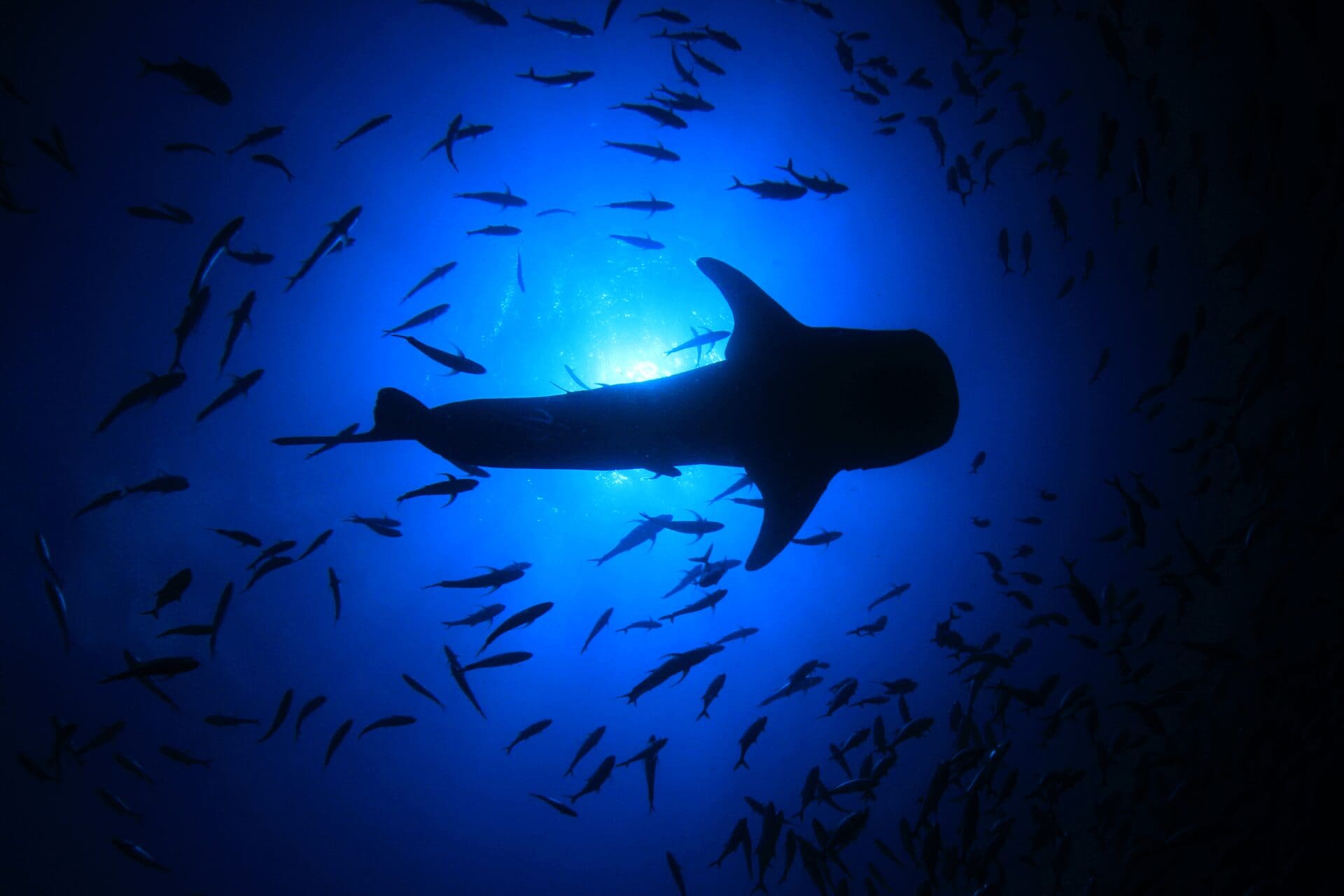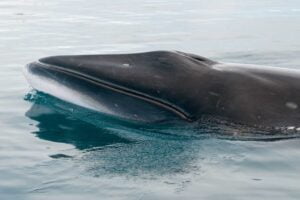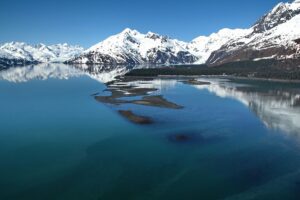From Humpbacks to Orcas: Your Essential Whale Species Guide
With over 90 species of whales, dolphins, and porpoises, it can be overwhelming to learn about them all. However, having a basic understanding of these creatures can help us appreciate and protect them better.
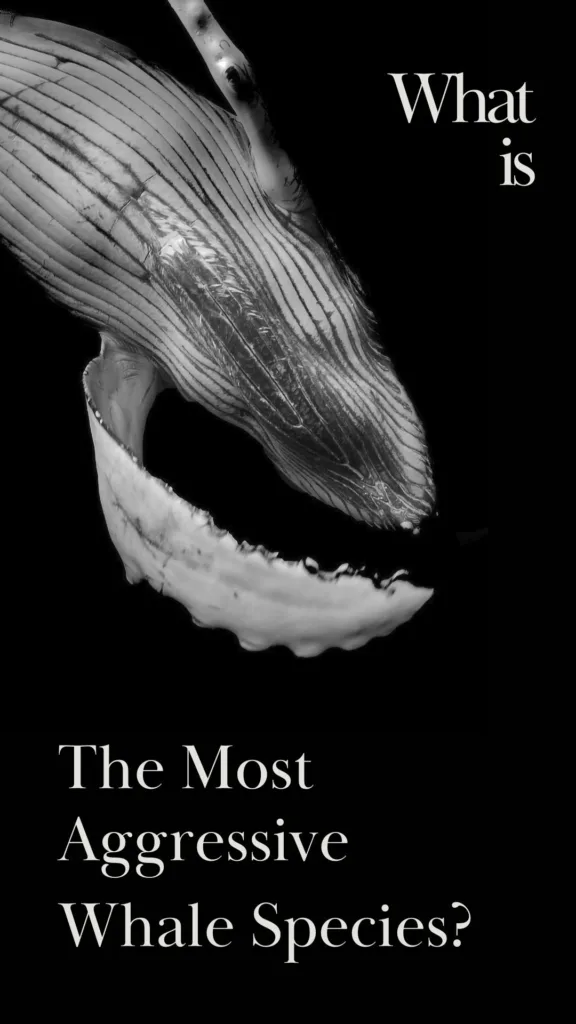

How Many Species of Whales Are There?
There are approximately 90 species of whales, dolphins, and porpoises, collectively known as cetaceans. These are divided into two main groups: baleen whales (Mysticeti) with 15 species, and toothed whales (Odontoceti), which include sperm whales, beaked whales, dolphins, and porpoises.
What Is the Most Aggressive Whale Species?
The killer whale (Orcinus orca), also known as the orca, is considered the most aggressive whale species. Orcas are apex predators and have been observed attacking large whales and sharks.
What Are the Three Largest Whales?
- Blue Whale (Balaenoptera musculus) – The largest whale, reaching lengths up to 100 feet (30 meters).
- Fin Whale (Balaenoptera physalus) – The second-largest, growing up to 85 feet (26 meters).
- Sperm Whale (Physeter macrocephalus) – The largest toothed whale, reaching up to 60 feet (18 meters).
What’s the Most Common Whale?
The most common whale species is the humpback whale (Megaptera novaeangliae), known for its widespread distribution in oceans around the world and its distinctive breaching behavior.
What Is the Rarest Whale?
The spade-toothed whale (Mesoplodon traversii) is considered the rarest whale, with only a few specimens ever identified, making it the least observed and most mysterious whale species.
What Is the Rarest of All Large Whales?
The North Atlantic right whale (Eubalaena glacialis) is one of the rarest large whales, with a population critically endangered due to historical whaling, ship strikes, and entanglement in fishing gear.
What Is the Coolest Whale in the World?
Subjective to opinion, many consider the narwhal (Monodon monoceros), with its unique long tusk, as one of the coolest whales. This “unicorn of the sea” inhabits Arctic waters and has fascinated people for centuries.
What Is the Largest Whale Ever Recorded?
The largest whale ever recorded is a blue whale, which was measured at about 110 feet (33.5 meters) long. However, most blue whales grow to lengths of 70-100 feet (21-30 meters).
What Is the Least Endangered Whale?
The least endangered whale is the minke whale (Balaenoptera acutorostrata), which has a relatively stable and abundant population compared to other whale species.
What Whale Is Almost Extinct?
The vaquita (Phocoena sinus), the world’s smallest cetacean, is almost extinct, with an estimated population of fewer than 20 individuals remaining, confined to the northern Gulf of California.
What Whale Was Almost Hunted to Extinction?
The gray whale (Eschrichtius robustus) was almost hunted to extinction in the 20th century but has made a significant recovery since whaling was banned.
What Whales Are Not Friendly?
While “friendly” is subjective, certain species like the sperm whale (Physeter macrocephalus) can be solitary and less likely to interact with humans. However, aggression is rare and usually occurs if they feel threatened.
What Is the Safest Whale to Swim With?
Swimming with humpback whales is often considered safe under controlled and respectful conditions, as they are generally curious about humans but maintain a gentle demeanor.
What Is a Whale’s Worst Enemy?
Apart from humans, who have historically been the biggest threat to whales through hunting and habitat destruction, large sharks and killer whales (orcas) are natural predators of some whale species, especially calves.
Classification of Whales
Whales are a group of aquatic mammals that belong to the order Cetacea. This order is further divided into Mysticeti (baleen whales) and Odontoceti (toothed whales).
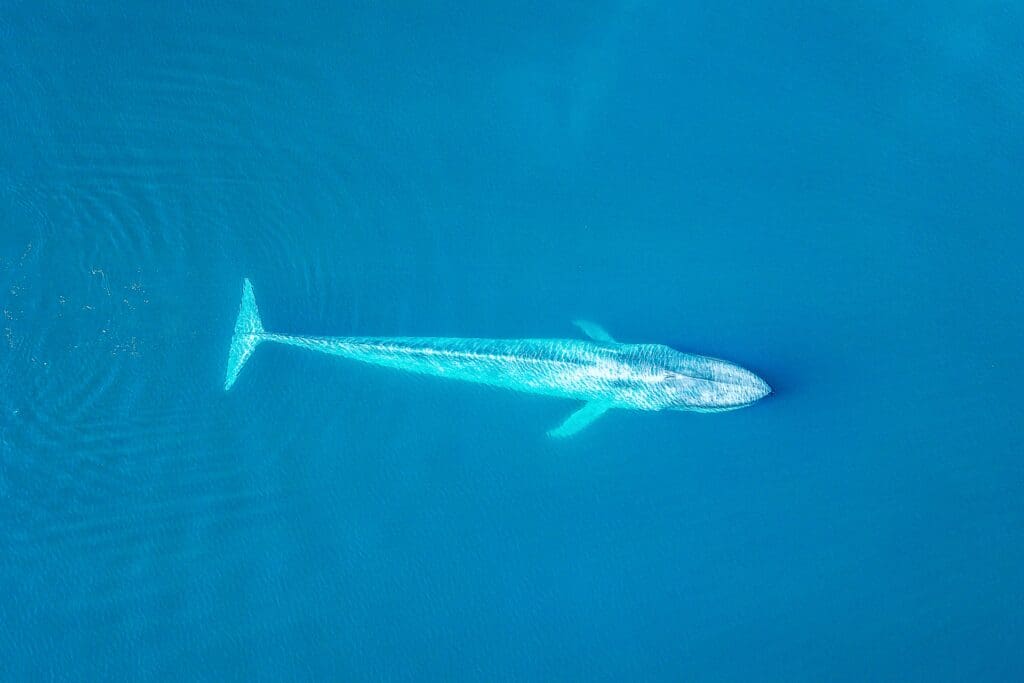

Baleen Whales
Baleen whales are named after their baleen plates, which are used to filter food from the water. Baleen whales are further divided into four families: Rorqual, Right, Gray, and Pygmy Right Whale. The largest animal on Earth, the Blue Whale, is a type of Rorqual whale. Bowhead Whales and North Atlantic Right Whales belong to the family of Right Whales. Humpback Whales and Fin Whales belong to the family of Rorqual whales. Gray Whales and Pygmy Right Whales are a part of the family of Gray Whales.
| Baleen Whale Species | Approximate Size | Regions to See Them |
|---|---|---|
| Blue Whale | Up to 100 feet (30 meters) | North Atlantic, North Pacific, Antarctic |
| Humpback Whale | 48 to 62 feet (14.6 to 18.9 meters) | North Atlantic, North Pacific, and Southern Ocean near Antarctica |
| Gray Whale | 44 to 49 feet (13.4 to 15 meters) | Eastern North Pacific, particularly along the coast of California during migration |
| Minke Whale | 23 to 33 feet (7 to 10 meters) | North Atlantic, North Pacific, Antarctic |
| Fin Whale | Up to 89 feet (27 meters) | Worldwide, commonly found in the Gulf of California, the Coral Triangle, and the Arctic |
| Bowhead Whale | 49 to 59 feet (15 to 18 meters) | Arctic and sub-Arctic waters, including the Bering Sea and the Sea of Okhotsk |
| Right Whale | 45 to 55 feet (13.7 to 16.8 meters) | North Atlantic, North Pacific, Southern Ocean near Antarctica |
These whales can often be seen during their migration seasons or in feeding grounds, depending on the time of year and specific regional conditions. Remember, the best times and places to see these magnificent creatures can vary, so it’s always a good idea to check with local whale-watching tours for the most current information.
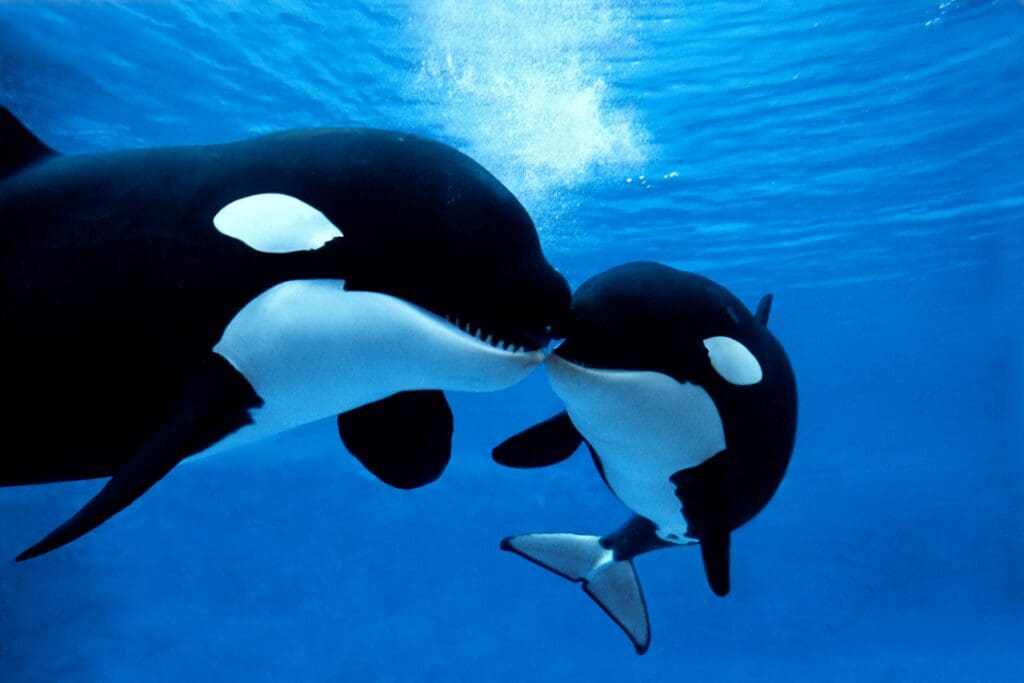

Toothed Whales
Toothed whales are named after their teeth, which are used to catch and eat prey. Toothed whales include Sperm, Beaked, Dolphins, Porpoises, and Beluga Whales. The largest toothed whale is the Sperm Whale, which can grow up to 67 feet in length. Orcas, also known as Killer Whales, are the largest member of the dolphin family.
| Toothed Whale Species | Approximate Size | Regions to See Them |
|---|---|---|
| Sperm Whale | Up to 59 feet (18 meters) | Worldwide, commonly seen in the Pacific Ocean, the Atlantic Ocean, and the Indian Ocean |
| Orca (Killer Whale) | 23 to 32 feet (7 to 9.7 meters) | Worldwide, frequently spotted in the Pacific Northwest, Norway, and Antarctica |
| Beluga Whale | 13 to 20 feet (4 to 6.1 meters) | Arctic and sub-Arctic, commonly seen in the St. Lawrence River, Canada, and the Arctic Ocean |
| Narwhal | 13 to 18 feet (4 to 5.5 meters) | Arctic waters, particularly around Greenland and Canada |
| Pilot Whale | 12 to 24 feet (3.7 to 7.3 meters) | Worldwide, often seen off the coast of California, in the North Atlantic, and around New Zealand |
| Bottlenose Dolphin | 10 to 14 feet (3 to 4.3 meters) | Worldwide in warm and temperate seas, commonly found in the Gulf of Mexico, the Mediterranean Sea, and the Pacific Ocean |
| Risso’s Dolphin | 8.5 to 13 feet (2.6 to 4 meters) | Worldwide, with sightings common in the Pacific Ocean near California and in the Mediterranean Sea |
These toothed whales can be found in various oceans and seas worldwide. Their visibility can depend on the season, migration patterns, and specific regional conditions. Local whale-watching tours and marine wildlife organizations can provide the most accurate and up-to-date information on the best times and locations to observe these incredible creatures.
River Dolphins
River Dolphins are a group of toothed whales that live in freshwater rivers and estuaries. These dolphins are adapted to their freshwater habitat and have evolved to have a long, narrow snout, which they use to catch fish. The Baiji, also known as the Chinese River Dolphin, is one of the world’s most endangered species of dolphins. Hector’s Dolphin is the smallest and rarest dolphin species in the world.
In conclusion, the classification of whales is based on their physical characteristics, feeding habits, and habitat. Understanding the different types of whales can help us appreciate the diversity of life on our planet and the importance of protecting these magnificent creatures.
| River Dolphin Species | Approximate Size | Regions to See Them |
|---|---|---|
| Amazon River Dolphin (Pink Dolphin) | Up to 8.2 feet (2.5 meters) | Amazon and Orinoco River basins in South America |
| South Asian River Dolphin (Ganges and Indus River Dolphin) | 7 to 8.5 feet (2.1 to 2.6 meters) | Ganges, Brahmaputra, and Indus River systems in South Asia |
| Chinese River Dolphin (Baiji) | Up to 8 feet (2.4 meters) | Yangtze River in China (Note: The Baiji is functionally extinct, with no confirmed sightings in recent years) |
| Araguaian River Dolphin | Up to 8.5 feet (2.6 meters) | Araguaia-Tocantins basin in Brazil |
| La Plata Dolphin (Franciscana) | 4.6 to 5.6 feet (1.4 to 1.7 meters) | Coastal areas of southeastern South America, including parts of Argentina, Brazil, and Uruguay |
River dolphins are unique in their adaptation to freshwater environments. They are generally smaller and more agile than their oceanic counterparts, with distinct features adapted to river habitats. These species are often threatened and face various challenges due to habitat degradation, pollution, and human activities. Conservation efforts are crucial for their survival. If you’re interested in seeing river dolphins, it’s important to choose responsible and eco-friendly tours that prioritize the well-being of these animals and their habitats.
Unique Behaviors and Adaptations
Whales exhibit a fascinating array of behaviors and adaptations that captivate us and are crucial for their survival and reproduction. Each species has developed unique strategies and characteristics to thrive in the diverse marine environments of our planet.
Singing: The Mystical Language of Whales
- Humpback Whales: Known for their complex and melodious songs, humpback whales use these vocalizations primarily during mating seasons. These songs, which can last for hours, are believed to attract mates and establish dominance among males.
- Other Species: While humpbacks are the most famous singers, other baleen whales, like the blue and fin whales, also communicate using lower-frequency sounds, which can travel great distances underwater.
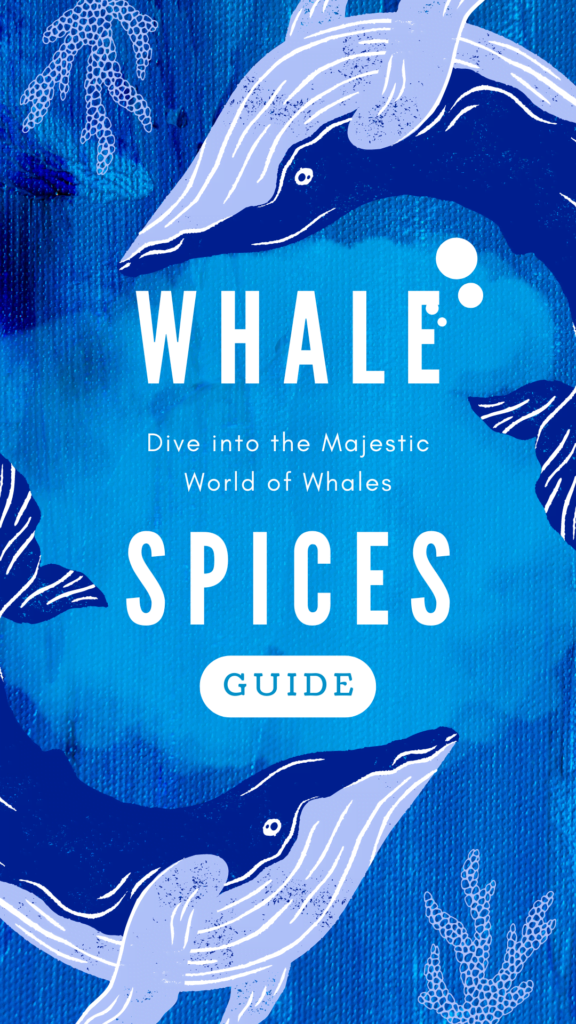

Hunting Strategies: The Art of Ocean Predation
- Orca (Killer Whale): Orcas are known for their sophisticated hunting techniques. They use coordinated attacks, often herding fish or seals into tight groups before striking. Some populations have even developed unique methods like beaching themselves to catch seals.
- Sperm Whales: These deep-diving hunters use echolocation to find their prey, primarily giant squids, in the ocean’s dark depths. They can dive over 2,000 feet deep and hold their breath for up to 90 minutes.
Migration: The Long Journey
- Gray Whales: Renowned for their long migratory journeys, gray whales travel up to 12,000 miles round-trip between their feeding grounds in the Arctic and breeding grounds in the warmer waters of Mexico.
- Baleen Whales: Many baleen whales undertake seasonal migrations to access rich feeding areas in the colder waters and then return to warmer tropical waters for breeding and giving birth.
Social Structures and Communication
- Dolphins and Orcas: These intelligent creatures have complex social structures and exhibit behaviors like cooperative hunting, play, and intricate communication. Their social bonds are strong, often lasting a lifetime.
- Beluga Whales: Known for their diverse vocalizations, belugas can produce a wide range of sounds, earning them the nickname “canaries of the sea.”
Adaptations for Survival
- Baleen Plates: Baleen whales have baleen plates instead of teeth, which they use to filter-feed on small fish and krill.
- Blubber: Thick layers of blubber provide insulation in cold waters and energy reserves.
Reproductive Strategies
- Calving Grounds: Many whales travel to specific, safer waters to give birth, ensuring a higher survival rate for their calves.
- Extended Care: Whale calves often stay with their mothers for extended periods, learning essential survival skills.
These behaviors and adaptations are not just fascinating aspects of whale biology; they are essential for the survival of these species. Understanding and appreciating these traits can deepen our respect for these magnificent creatures and highlight the importance of protecting their habitats and ensuring their continued existence in our world’s oceans.
Habitats and Distribution
As diverse as they are in species, whales are equally varied in their habitats and distribution across the world’s oceans. Each species has adapted to thrive in specific environments, from the icy waters of the Arctic to the warmer tropical seas.
Whale Habitats:
- Polar Regions: Species like the bowhead whale and certain populations of orcas and humpback whales are adapted to the frigid waters of the Arctic and Antarctic. They have developed physical adaptations like thick blubber to survive in these icy environments.
- Temperate Waters: Many baleen whales, including gray whales and fin whales, are found in temperate waters. These regions offer rich feeding grounds, particularly during the summer months.
- Tropical and Subtropical Waters: Warmer waters primarily breed and calving grounds for species like humpback whales, who migrate to these areas during winter.
- Riverine Environments: Unique species like the Amazon river dolphin (pink dolphin) and the South Asian river dolphin inhabit freshwater environments, showcasing a remarkable adaptation from their marine counterparts.
Arctic Whales:
- Beluga Whale: The Arctic and sub-Arctic regions are home to the distinctively white beluga whale. Known for their sociable nature, belugas often travel in groups or ‘pods’, navigating the icy waters with remarkable agility.
- Narwhal: Sharing the Arctic waters with the beluga is the narwhal, famous for its long, spiral tusk. Narwhals are uniquely adapted to life in the Arctic, with their deep diving capabilities and preference for icy habitats.
- Bowhead Whale: Another Arctic inhabitant, the bowhead whale, is known for its massive head and baleen plates. Adapted to life in the Arctic, bowheads can break through thick ice to create breathing holes.
Antarctic Whales:
- Humpback Whale: The Southern Ocean around Antarctica is a crucial feeding ground for humpback whales. Known for their impressive migrations, they travel thousands of miles to breed in warmer waters and return to the Antarctic to feed.
- Killer Whale (Orca): Orcas, the largest members of the dolphin family, are found in all of the world’s oceans, including the Antarctic. They are versatile predators, feeding on various prey, and are known for their complex social structures.
Oceanic Whales:
- Blue Whale: The blue whale, the largest animal on earth, roams all of the world’s oceans. Their blue-gray coloration and immense size are awe-inspiring. Blue whales primarily feed on krill and are known for their long, deep dives.
- Sperm Whale: Sperm whales, famous for their deep diving in search of giant squids, inhabit open oceans. They have a global distribution and are often found in deep offshore waters.
- Fin Whale and Minke Whale: These species are also widespread in the open ocean, with fin whales being the second-largest whale species and minke whales one of the smaller baleen whales.
Impact of Climate Change
- Shifting Food Sources: Climate change is causing shifts in ocean temperatures and currents, affecting the distribution of krill and fish, the primary food sources for many whale species.
- Altered Migration Patterns: As feeding grounds change, whales are forced to adjust their migration routes, increasing energy expenditure and affecting their breeding success.
- Melting Ice Caps: Ice reduction in polar regions poses a significant threat to species like the bowhead whale, which relies on these environments for survival.
Human Activities and Their Impact
- Pollution: Chemical and noise pollution from human activities pose significant threats to whale habitats. Chemicals can contaminate their food sources, while noise pollution disrupts their communication and navigation abilities.
- Ship Traffic: Increased maritime traffic can lead to habitat disturbance and a higher risk of ship strikes, which are fatal to whales.
- Fishing Practices: Entanglement in fishing gear is a major threat to many whale species. Responsible fishing practices and gear modifications are essential to reduce these incidents.
- Habitat Destruction: Coastal development and other human activities can destroy crucial breeding and feeding grounds.
The habitats and distribution of whales are a complex interplay of ecological, climatic, and human factors. Protecting these environments is not just about conserving whale populations; it’s about maintaining the health of our oceans. As we continue to understand the impact of climate change and human activities on these habitats, it becomes increasingly important to take action to mitigate these effects and ensure the survival of these magnificent creatures for future generations.
Threats to Whales
Whales face a multitude of threats in their natural habitats. Some of these threats result from human activity, while others are natural. Understanding these threats is essential to protect these majestic creatures.
Climate Change
Climate change is one of the most significant threats to whales. It affects the food chain and can alter the migration patterns of whales. For example, the North Pacific right whale is particularly vulnerable to the effects of climate change. The eastern population of this species has only about 30 individuals, and climate change is considered one of the most significant threats to its survival.
Pollution
Pollution is another significant threat to whales. Chemicals and pollutants from human activities can accumulate in the tissues of whales and other marine mammals, leading to health problems and even death. For instance, plastic pollution is a growing problem for whales. Whales can mistake plastic waste for food, leading to ingestion and entanglement.
Entanglement
Entanglement in fishing gear is a significant threat to many whale species. Whales can become entangled in fishing gear, such as nets and lines, leading to injury or death. For example, the North Atlantic right whale is one of the most endangered whale species, and entanglement in fishing gear is a significant threat to its survival.
Collisions with Ships
Collisions with ships are also a significant threat to whales. Large ships can strike whales, leading to injury or death. For example, the North Atlantic right whale is also threatened by ship collisions.
In conclusion, whales face a variety of threats in their natural habitats. Some of these threats result from human activity, while others are natural. Understanding these threats is essential to protect these majestic creatures. Climate change, pollution, entanglement in fishing gear, and collisions with ships are some of the most significant threats to whale populations.
Whaling History and Legislation
Whaling is the hunting of whales for their meat, oil, and other byproducts. It has been practiced for centuries, with evidence of organized whaling by the Basques dating back to 700 AD. However, the practice has become increasingly controversial over the past few decades due to concerns over the conservation of whale populations and animal welfare.
Whaling in Different Regions
Whaling has been practiced in different regions worldwide, with Japan, Norway, and Iceland being the only countries that still engage in commercial whaling. Japan has been a major whaling nation, with its whalers hunting whales in the Antarctic and North Pacific. On the other hand, Norway has been hunting minke whales in its coastal waters.
In the United States, whaling was a major industry in the 19th century, with California being a hub for the whaling industry. However, the industry declined due to the depletion of whale populations and the discovery of oil.
Whaling Moratorium
In 1986, the International Whaling Commission (IWC) implemented a moratorium on commercial whaling, which banned the hunting of all great whales. The moratorium was put in place due to concerns over the conservation of whale populations. Despite the moratorium, whaling has continued in some countries, including Japan, Norway, and Iceland, who have continued to hunt whales for scientific research or under the guise of “aboriginal subsistence.”
Endangered Whale Species
Many whale species are endangered due to overhunting and habitat destruction. The vaquita, a small porpoise found in the Gulf of California, is one of the most endangered marine mammals in the world, with only a few dozen individuals left in the wild.
Several laws and regulations have been put in place to protect endangered whale species, including the Endangered Species Act (ESA) in the United States. The ESA protects both endangered and threatened species, including all great whales. The Convention on International Trade in Endangered Species (CITES) also regulates the trade of whale products to prevent further harm to whale populations.
Conservation Status
The conservation status of whale species varies, with many facing significant threats due to human activities. Understanding these threats and the efforts being made to protect these magnificent creatures is crucial for their survival and the health of our oceans.
Conservation Status of Various Whale Species
- Endangered Species: The blue, fin, and North Atlantic right whales are listed as endangered. Factors like historical whaling have drastically reduced their populations.
- Vulnerable Species: Species like the humpback whale and the sperm whale are considered vulnerable. While their numbers have improved due to conservation efforts, they still face threats that could impact their recovery.
- Least Concern: Some species, like the minke whale, are not currently considered endangered. However, they still face threats that could change their status if not managed properly.
Threats to Whale Populations
- Whaling: Historically, commercial whaling was the primary threat to whales, leading to the near-extinction of several species. While commercial whaling has significantly reduced, it still exists in some countries.
- Habitat Destruction: Coastal development, pollution, and climate change are leading to habitat degradation, affecting whale feeding and breeding grounds.
- Entanglement in Fishing Gear: Many whales die each year after becoming entangled in fishing nets and gear.
- Ship Strikes: Increasing maritime traffic has led to more collisions between whales and large vessels, often resulting in serious injuries or death for the whales.
- Climate Change: Changes in ocean temperatures and currents affect the distribution of krill and small fish, impacting the food sources for many whale species.
- Noise Pollution: Increased noise from shipping, military activities, and oil exploration disrupts whale communication and navigation.
Conservation Efforts
- International Whaling Commission (IWC): The IWC regulates whaling activities and promotes whale conservation. [1]
- Marine Protected Areas (MPAs): Establishing MPAs helps protect crucial whale feeding and breeding grounds. [2]
- Species-Specific Conservation Programs: Programs targeting specific species or populations are critical, especially for at-risk populations.
- Research and Monitoring: Ongoing research is essential for understanding whale populations and the impacts of various threats. This information is crucial for effective conservation strategies.
- Public Awareness and Education: Educating the public about whales and their threats is vital for garnering support for conservation efforts.
- Collaboration with Fisheries: Working with the fishing industry to develop whale-safe fishing gear and practices can significantly reduce entanglement deaths.
The conservation of whale species is a complex issue that requires a multifaceted approach. It involves international cooperation, effective policy implementation, scientific research, and public engagement. By continuing to work on these fronts, there is hope for these majestic sea creatures’ recovery and long-term survival.

